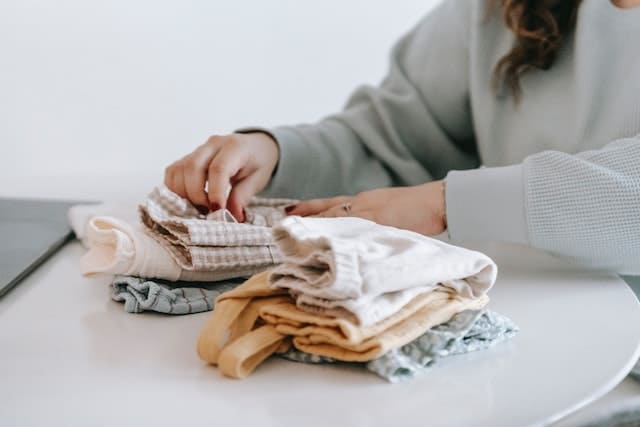Chewing on clothes is a common symptom that is often associated with certain conditions such as autism, anxiety, and sensory processing disorder. It is a behavior that involves biting, sucking, or chewing on clothing items such as sleeves, collars, or cuffs.
While it may seem like a harmless habit, it can have negative effects on dental health and social interactions.
Understanding the Behavior of Chewing on Clothes Chewing on clothes is a sensory-seeking behavior that provides comfort and relief to individuals with sensory processing difficulties. It is a way to regulate sensory inputs and meet sensory needs.
However, it can also be a sign of anxiety, stress, or boredom. It is important to understand the underlying causes of this behavior in order to address it effectively.
Key Takeaways:
- Chewing on clothes is a sensory-seeking behavior that provides comfort and relief to individuals with sensory processing difficulties.
- It can also be a sign of anxiety, stress, or boredom.
- Understanding the underlying causes of this behavior is important for effective intervention.
Understanding the Behavior of Chewing on Clothes
Chewing on clothes is a behavior that some children exhibit, and it can be a symptom of various underlying issues. This behavior is characterized by a child chewing on any part of their clothing, such as the collar, sleeves, or buttons.
While it is not uncommon for children to put objects in their mouth, such as toys or fingers, chewing on clothes is a behavior that can be concerning for parents and caregivers.
There are various reasons why a child may chew on their clothes. Some children may have sensory processing issues, which can cause them to seek out sensory stimulation by chewing. Others may have anxiety or stress and use chewing as a way to self-soothe.
Additionally, children with attention deficit hyperactivity disorder (ADHD) or autism spectrum disorder (ASD) may exhibit this behavior.
It is important for parents and caregivers to understand that chewing on clothes is not necessarily a deliberate or attention-seeking behavior. Instead, it may be a coping mechanism for the child.
It is also important to note that chewing on clothes can be harmful, as it can damage the clothing and potentially lead to ingestion of harmful substances.
If a child is exhibiting this behavior, it is recommended to consult with a healthcare professional or therapist to determine the underlying cause and develop a plan to address it.
This may include providing alternative sensory tools, such as chewable jewelry or toys, or implementing behavioral strategies to address anxiety or stress.
Overall, understanding the behavior of chewing on clothes is an important step in addressing it effectively.
By identifying the underlying cause and providing appropriate support, parents and caregivers can help their child overcome this behavior and promote their overall well-being.
Possible Causes
Chewing on clothes is a common symptom that can be caused by a variety of factors.
Here are some of the possible causes:
Anxiety and Stress
Anxiety and stress can cause people to chew on their clothes as a way to cope with their emotions. This behavior can provide a sense of comfort and security, and may help to reduce feelings of anxiety or stress.
Sensory Processing Disorder
Sensory processing disorder is a condition in which the brain has difficulty processing information from the senses. People with this disorder may chew on their clothes as a way to regulate their sensory input and feel more comfortable.
Oral Fixation
An oral fixation is a psychological condition in which a person has a strong desire to put objects in their mouth. This can lead to chewing on clothes as a way to satisfy this urge.
Boredom
Boredom can also be a cause of chewing on clothes. When people are bored, they may engage in repetitive behaviors like chewing on their clothes to pass the time.
ADHD and Autism
Chewing on clothes is also common among people with ADHD and autism. These conditions can cause hyperactivity and sensory processing difficulties, which can lead to the need for oral stimulation.
In conclusion, chewing on clothes can be caused by a variety of factors, including anxiety, sensory processing disorder, oral fixation, boredom, ADHD, and autism. It is important to seek professional help if this behavior becomes excessive or interferes with daily life.
The Role of Non-Food Objects
Chewing on non-food objects is a common behavior among children and adults alike. This behavior is known as pica, and it can be a symptom of various conditions, including anxiety, stress, and developmental disorders.
In this section, we will explore the role of non-food objects, such as pens, pencils, and clothes, in pica.
Pens and Pencils
Chewing on pens and pencils is a common habit among students and office workers. While it may seem harmless, this behavior can lead to dental problems, such as chipped or broken teeth.
Additionally, chewing on pens and pencils can be a sign of anxiety or stress, and it may interfere with concentration and productivity.
To prevent this behavior, individuals can try using fidget toys or stress balls as an alternative to pens and pencils. They can also practice relaxation techniques, such as deep breathing or meditation, to reduce stress and anxiety.
Clothes
Chewing on clothes is a common symptom of pica, especially among children with developmental disorders, such as autism or ADHD.
This behavior can be dangerous if the individual swallows the fabric, which can lead to choking or intestinal blockages.
To prevent this behavior, parents and caregivers can provide safe chew toys or sensory tools, such as chewable necklaces or bracelets. They can also seek professional help to address underlying conditions that may be causing pica.
In conclusion, chewing on non-food objects can be a symptom of various conditions, and it can lead to dental problems and other health risks.
By understanding the role of non-food objects in pica, individuals can take steps to prevent this behavior and address underlying conditions.
Effects on Dental Health
Chewing on clothes can have negative effects on dental health. When individuals chew on clothing, it can cause damage to teeth, gums, and overall oral health. This behavior can lead to a variety of dental issues, including tooth decay.
Repeatedly biting down on clothing can cause teeth to shift and become misaligned. This can lead to further dental problems, such as tooth decay and gum disease.
Additionally, chewing on clothes can cause damage to dental work, such as fillings or braces.
Furthermore, the fabric fibers from clothing can get stuck between teeth and cause irritation to the gums. This can lead to inflammation and bleeding, which can increase the risk of gum disease.
In summary, chewing on clothes can have negative effects on dental health. It can cause damage to teeth and gums, and increase the risk of dental issues such as tooth decay and gum disease.
Individuals who engage in this behavior should seek professional help to address the underlying causes and protect their oral health.
Coping Mechanisms and Comforting Aspects
For individuals who experience the symptom of chewing on clothes, coping mechanisms and comforting aspects can be helpful in managing the behavior.
Coping mechanisms refer to the strategies that individuals use to deal with stress and difficult emotions, while comforting aspects refer to the things that provide comfort and a sense of security.
One effective coping mechanism is to identify triggers that lead to the behavior and develop a plan for managing them. This may involve avoiding certain situations or activities that trigger the behavior, or finding alternative ways to cope with stress and anxiety.
For example, a person may find that chewing on clothes is more likely to occur when they are feeling anxious or overwhelmed. In this case, they may try deep breathing exercises or meditation to manage their anxiety instead of resorting to the behavior.
Another important coping mechanism is to seek support from others. This may include talking to a therapist or counselor about the behavior and developing a plan for managing it, or reaching out to friends and family for emotional support.
Support groups can also be helpful in connecting with others who are experiencing similar challenges.
In addition to coping mechanisms, self-soothing techniques can also be helpful in managing the behavior. Self-soothing refers to activities that provide comfort and a sense of security, such as taking a warm bath, listening to calming music, or engaging in a relaxing hobby.
These activities can help to reduce stress and anxiety, making it easier to manage the urge to chew on clothes.
Overall, managing the symptom of chewing on clothes can be challenging, but with the right coping mechanisms and comforting aspects in place, individuals can learn to manage the behavior and improve their quality of life.
Sensory Inputs and Needs
Individuals who chew on clothes may have specific sensory inputs and needs that are not being met.
Sensory inputs refer to the information that our senses receive from the environment, and sensory needs are the requirements that individuals have to process this information effectively.
Some individuals may experience sensory overload, which means that they are receiving too much sensory input and are unable to process it effectively. This can lead to anxiety, irritability, and other negative symptoms.
Chewing on clothes may be a way for individuals to regulate their sensory input and reduce the amount of overwhelming information they are receiving.
On the other hand, some individuals may have sensory issues or hypersensitivity, which means that they are more sensitive to sensory input than others. This can lead to discomfort, pain, and other negative symptoms.
Chewing on clothes may provide oral stimulation that can help individuals regulate their sensory input and reduce the discomfort caused by hypersensitivity.
It is important to understand that chewing on clothes is not necessarily a negative behavior. It may be a way for individuals to meet their sensory needs and regulate their sensory input.
However, it is important to find safe and appropriate ways to meet these needs and avoid potential harm to oneself or others.
Professional Help and Treatment
If you or someone you know is experiencing the symptom of chewing on clothes, it is important to seek professional help. Depending on the severity and underlying cause of the behavior, different types of professionals may be able to provide effective treatment.
A pediatrician may be the first point of contact for parents of children who are exhibiting this behavior.
They can perform a physical exam and rule out any underlying medical conditions that may be contributing to the behavior. They may also refer the child to a specialist for further evaluation.
A therapist or counselor can help individuals identify the underlying emotional or psychological factors that may be causing the behavior. They can provide support and guidance to help individuals develop healthier coping mechanisms and address any underlying issues.
Specialists such as occupational therapists or speech therapists may also be able to provide effective treatment for chewing on clothes. They can work with individuals to develop alternative behaviors and sensory strategies to help reduce the urge to chew.
Applied behavior analysis (ABA) is another treatment option that may be effective for individuals with chewing on clothes. ABA focuses on identifying and modifying behaviors through positive reinforcement and other behavior modification techniques.
In some cases, a general practitioner (GP) may be able to provide treatment or refer individuals to other professionals as needed. It is important to work with a qualified professional who has experience in treating this behavior to ensure the best possible outcome.
Alternative Solutions
For those who experience the urge to chew on their clothes, there are several alternative solutions that can help reduce the behavior.
These solutions are designed to provide a safe and appropriate outlet for the individual to chew on, while also addressing any underlying sensory needs.
One popular solution is chewelry, which is a type of jewelry that is designed to be chewed on. Chewelry comes in a variety of shapes, sizes, and colors, and can be worn discreetly throughout the day.
This can be a great option for individuals who want to reduce their chewing behavior without drawing attention to themselves.
Another option is oral motor grabbers, which are small, handheld tools that are designed to be chewed on. These tools are often made from safe, non-toxic materials and can be used to provide a sensory outlet for individuals who experience the urge to chew.
Adaptive clothing is another solution that can be helpful for individuals who struggle with chewing on their clothes. These types of clothing are designed with specific sensory needs in mind, and may include features like reinforced seams or textured fabrics that can provide a sensory outlet.
Sensory chew toys are also a popular option for individuals who experience the urge to chew. These toys are designed to be chewed on and can provide a safe and appropriate outlet for the behavior.
Other alternatives include bandana bibs, which are designed to be worn around the neck and can provide a safe and discreet outlet for chewing, as well as chewable jewelry, which can be worn as a necklace or bracelet and can provide a safe and appropriate outlet for chewing.
Overall, there are many alternative solutions available for individuals who experience the urge to chew on their clothes. By finding the right solution that works for them, individuals can reduce their chewing behavior and improve their overall sensory experience.
Frequently Asked Questions
Is chewing clothes a sign of autism?
Chewing on clothes can be a sign of autism, but it is not always the case. It is a common symptom that can also be associated with other conditions such as anxiety, ADHD, and sensory processing disorder.
Is chewing clothes a sign of anxiety?
Yes, chewing on clothes can be a sign of anxiety. It is a common coping mechanism used by people with anxiety to relieve stress and tension.
Chewing on clothes and ADHD?
Chewing on clothes can be a symptom of ADHD. People with ADHD may engage in repetitive behaviors such as chewing to help them focus and relieve boredom.
Chewing clothes disorder in adults?
Chewing on clothes is not a disorder, but it can be a symptom of an underlying condition such as anxiety or sensory processing disorder. It is more common in children, but some adults may also engage in this behavior.
What causes a child to chew on clothes?
There is no one specific cause for a child to chew on clothes. It can be a way for them to self-soothe, relieve stress, or cope with anxiety. It can also be a sensory seeking behavior.
Why does my daughter keep chewing her clothes?
It is important to understand that chewing on clothes is a common behavior in children and can be caused by a variety of factors. It is important to observe your daughter’s behavior and seek professional help if necessary to determine the underlying cause.
Related Posts:

Iesha is a loving mother of 2 beautiful children. She’s an active parent who enjoys indoor and outdoor adventures with her family. Her mission is to share practical and realistic parenting advice to help the parenting community becoming stronger.



